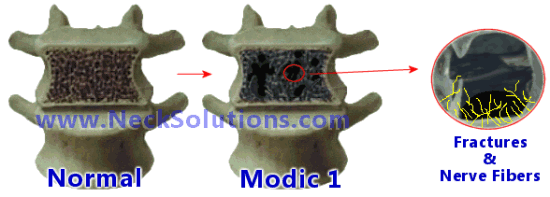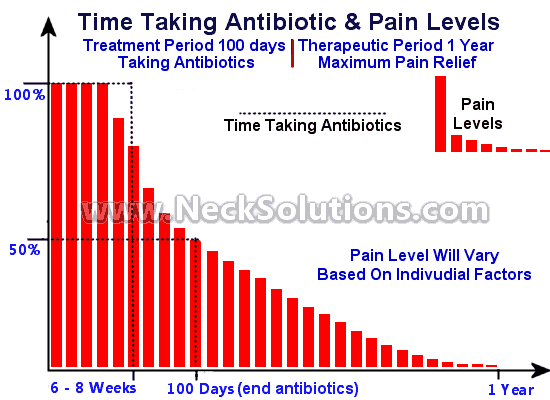Are you suffering from chronic back pain? You May Have Modic Changes In Your Spine.
If you have tried various treatments without relief, you may suffer from a finding in certain individuals with back pain called Lumbar Modic changes in the bones of the lumbar spine. A new approach may provide relief, where other typical methods fail.

About 6 percent of individuals have chronic back pain related to these Modic changes. Since these changes cannot be seen on standard x-rays, many do not get properly diagnosed. MRI scanning is necessary to determine if you have Modic changes, however, since treating these changes is relatively new, many radiologists consider them “normal”. Recent scientific studies indicate they are not normal and contribute to significant pain and are a rapid type of degeneration related to disc herniations and possibly bacterial infection.
Lumbar Modic changes
Modic change is a pathological condition effecting the structure of spinal bones. In 1988, Dr. Michael Modic discovered these changes by identifying and describing their characteristics on MRI scans. By looking at samples of bone, Dr. Modic was able to establish 3 different types of modic changes.
Normal bone is sometimes called Modic type 0 – no Modic changes. A normal spinal bone is not solid inside, it has thin threads that form a type of scaffolding for bone marrow that forms blood cells.
Type 1
In Type 1 Modic change, the scaffolding structure is disrupted and the threads are fractured, weakening and deforming the structure inside the bone. When this occurs, the normal bone marrow, which is healthy and red, is instead changed to a blister-like clear fluid. This process allows a very sensitive type of nerve fibers to form inside the bone that cause pain.
Type 2
With Modic change Type 2, these broken threads of bone are also present and the scaffolding structure in the bone remains deformed, but rather than the clear fluid that has replaced red marrow in Type 1, Type 2 consists of fat. This yellow fat is much the same as the fat we complain about on our belly and hips.
Type 3
Modic change Type 3 is not very common and is the rarest of the Modic types. This type consists of scar tissue that has formed in the diseased bone.
Lumbar Modic Changes & Back Pain
If you have been suffering from back pain with little or no results from different traditional therapies, it is important to know if you are suffering from Modic changes. Scientific studies on Modic changes clearly indicates a relationship between Modic changes and back pain, especially Type 1.
Modic changes produce more pain than typical muscular back pain that does not have the bone changes associated with Modic changes. Most Modic changes produce back pain that is constant. The pain may be more or less depending on the time of day and the amount of physical activity, however, it never really goes away, it’s always there. Many suffer back pain that can wake them up at night when turning in bed.
Do I have Modic Changes?
To determine if you have Modic changes, a careful history, physical exam and MRI must be done by a qualified health care professional. However, there is a questionnaire that can help determine if you might suffer back pain from Modic 1 changes, based on the symptoms.
If you note a positive response to 3 or more of these, you might have lumbar Modic changes that need further evaluation:
1) Low back pain at night. 2) Pain waking you up at night when turning over. 3) Pain worse in morning, easing during the day, gets worse in afternoon and at night. 4) Back pain deep in the back. 5) Sometimes pain going into the leg(s). 6) Back pain worse or not changed when exercising or doing physical activities. 7) X-rays that have shown disc degeneration. 8) Back pain constant for most of the day. 8) Treatments used to help back pain, but do not provide relief.
Treatment For Modic Changes

As indicated in a 2013 study in the European Spine Journal, Modic changes are often caused by bacteria entering the disc through a disc herniation, therefore, treatment consists of antibiotics taken for 100 days to destroy the bacteria that secrete a substance which damages the bones.
Antibiotics are not meant to be taken lightly, if there are clear indications that you are suffering back pain from this condition, contraindications to taking strong antibiotics for a long period must be considered. The treatment with antibiotics lasts for 100 days, but the effects may not be seen for a period or weeks or months, because the antibiotics need a long time to get into the disc. Full recovery may take a year, so patience and understanding about the condition is necessary. Therefore, finding someone who is certified or very knowledgeable about Modic Antibiotic Spinal Therapy and can educate and answer questions regarding lumbar Modic changes and antibiotics is a good idea to achieve best results.
This treatment is generally well accepted in Europe, however, here in the States, antibiotic spinal therapy is not so accepted. As more studies are done and results from clinics in Europe are favorable, this status in the U.S. should change. A preponderance of evidence indicates Modic changes are a significant factor in chronic back pain and disability, as well as complications to recovery and surgeries.
Knowledgeable doctors here in the States are implementing the protocol with select patients and doctors who have successfully completed the certification course from the Author of the original studies, like Dr. Steve, can help with advice by corresponding with individuals and doctors. Additionally, there is a significant amount of information regarding Modic changes and antibiotic therapy for individuals and health care professionals at NeckSolutions.
In Europe, they are also using a bio-stimulating laser for therapy to assist the healing of bone threads that have become fractured, decreasing inflammation so prevalent in Modic Type 1 changes and to provide pain relief while waiting for the effects of the antibiotics.
Not everyone gets better. Some cannot take the antibiotics and some do not respond as the Modic changes may be more structural in nature, however, new methods are being studied and the future is promising. For some, the antibiotic treatment helps to eliminate the cause of Lumbar Modic changes, greatly improving the quality of life. Some patients are able to get back to work and back to life again.
A 2021 study in the International Journal of Molecular Sciences indicates, “While still controversial, the role of C. acnes [formerly p. acnes] in DDD [degenerative disc disease] remains biologically credible, and its ability to cause disease likely reflects a combination of factors, particularly individualised response to infection.”
A 2021 review in Clinical Spine Surgery indicates type 1 Modic changes have been strongly associated with inflammation and severe low back pain. Theories have been proposed including infection, mechanics, genetic factors, and autoimmunity. The authors conclude, “Improved diagnostic methods in clinical practice are thus critical to properly identify patients suffering from MC [Modic changes], plan early intervention, and hasten return to functioning.
A 2021 study in Orthopedic Reviews indicates regarding low back pain, “Age-related changes to the vertebral column and Modic changes are among the most common culprits for a patient’s pain.”
A 2022 study in Microbes and Infection found induced discogenic low back pain is via the production of nerve growth factor by Propionibacterium acnes. The authors indicate P. acnes had a strong association with low back pain by stimulating nucleus cells of the discs to secrete nerve growth factor.
While progressing to Type II is a less painful form, it can still be problematic. A 2022 study in World Neurosurgery noted percutaneous endoscopic lumbar discectomy (PELD) has become a popular surgical approach for lumbar radiculopathy caused by disc herniation. However, patients with type II Modic change may suffer from unrelieved low back pain and higher herniation recurrence after surgery. The authors recommend longer brace support or other interventions could be applied.
A 2023 study in the European Spine Journal found disc herniation location may be associated with a distribution pattern of Modic changes. Asymmetric changes were related to leg pain and higher pain levels than symmetrical changes.


